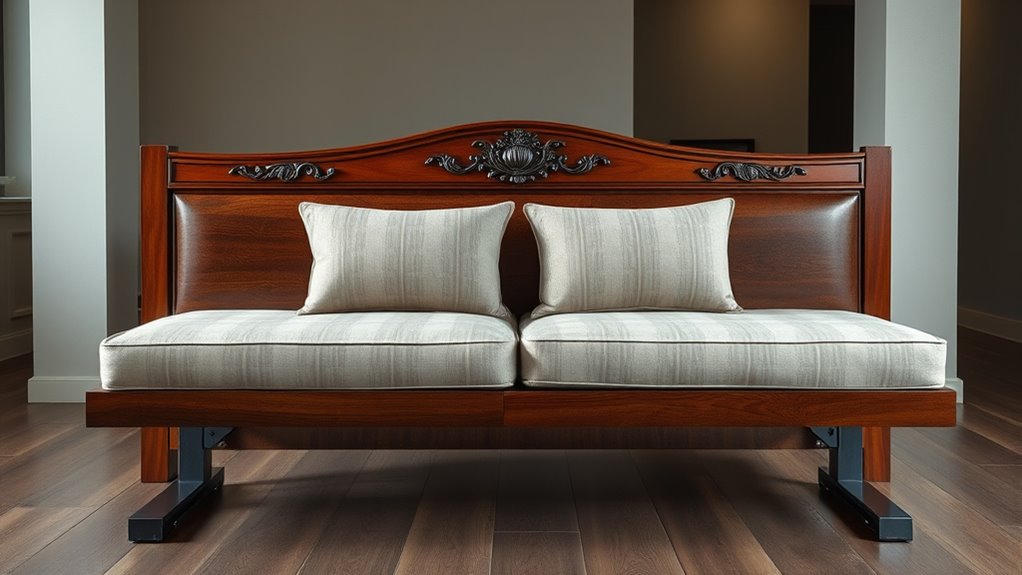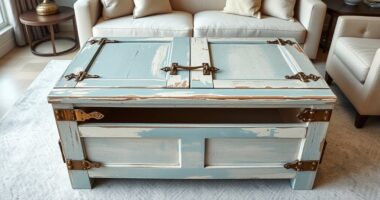When turning a headboard into bench seating, focus on its structural durability by ensuring it’s made from solid wood or sturdy materials that can support weight safely. Reinforce weak points with brackets or supports and securely fasten the headboard to a sturdy frame or base. Add a comfortable cushion onto a flat, stable surface, anchoring it well to prevent shifting. If you keep exploring, you’ll discover more tips to create a safe, stylish bench that lasts.
Key Takeaways
- Ensure the headboard material is durable and sturdy, capable of supporting weight without cracking or warping.
- Reinforce weak points with brackets or supports to improve overall stability and prevent wobbling.
- Build a solid and level platform or frame beneath the headboard for comfortable seating and structural integrity.
- Attach cushions securely with appropriate fasteners or adhesives, considering the cushion’s thickness and comfort.
- Mount the assembled bench to a stable base or frame to ensure safety and prevent shifting during use.

If you’re looking for a creative way to add functional style to your space, turning an old headboard into a bench is a smart solution. But before you start cutting and painting, it’s essential to consider the structural aspects to ensure safety and longevity. One of the first things to evaluate is the headboard’s material durability. You want a piece that can support weight without cracking or warping over time. Solid wood or sturdy engineered wood tends to hold up better than softer or composite materials. Check for any signs of damage, such as loose joints, splits, or rot, especially if the headboard has been used for many years. Reinforcing weak points with additional brackets or supports can help improve its overall strength and stability.
Next, consider how you’ll incorporate cushion placement. The seat of your bench needs to be comfortable and secure, which means planning for proper padding and support. If the headboard already has a flat surface, you might simply add a cushion on top. However, if it has decorative or uneven parts, you may need to build a platform or frame to create a level seating area. When attaching the cushion, ensure that the base is sturdy enough to hold it in place without shifting or sagging over time. Using a solid platform or frame behind or beneath the cushion supports better cushion placement and prevents wear and tear on the padding. This also makes cleaning and maintenance easier.
Considering the material durability goes hand-in-hand with how you attach the cushion. For added stability, opt for fasteners or adhesives suitable for the headboard’s material. For instance, if you’re working with wood, screws and wood glue work well, while for upholstered or softer materials, heavy-duty velcro or fabric ties might be more appropriate. Make sure your cushion is thick enough to provide comfort but not so bulky that it overwhelms the headboard’s design. Also, think about removable cushions for convenience, especially if you plan to wash or replace them periodically.
Additionally, selecting a design that complements your bedroom decor can enhance the overall aesthetic, especially if you aim for a cohesive farmhouse or rustic style. Lastly, don’t overlook the importance of a stable base. Whether you choose to mount the headboard directly to a frame or build a separate support structure, it needs to be secure. Use cross supports or brackets to distribute weight evenly and prevent wobbling. With these considerations in mind—material durability, cushion placement, and a solid foundation—you’ll transform your headboard into a functional, stylish bench that’s safe, comfortable, and built to last.
Frequently Asked Questions
What Tools Are Necessary for Converting a Headboard Into a Bench?
To convert a headboard into a bench, you’ll need basic tools like a saw, drill, screwdriver, and measuring tape. These help you cut, assemble, and secure structural parts. Consider adding decorative accents or upholstery options afterward to enhance its appearance and comfort. Make sure to have sandpaper for smoothing rough edges and fabric or padding for upholstery. With these tools, you can customize your bench to match your style and needs.
How Do I Ensure the Headboard Is Sturdy Enough for Seating?
To guarantee your headboard is sturdy enough for seating, check its material stability and weight capacity. Reinforce weak spots with additional bracing or wood supports, especially if it’s made of softer materials. Test the headboard by applying gentle pressure to see how it holds, and avoid using it for heavy or frequent seating if it lacks sufficient weight capacity. Proper reinforcement guarantees safety and durability for your bench.
Can I Customize the Height of the Converted Bench?
Did you know that adjustable height benches are gaining popularity for their versatility? You can definitely customize the height of your converted headboard bench to suit your needs. By adding adjustable legs or stacking support blocks, you create a personalized piece. This customization option not only enhances comfort but also makes your furniture more functional. Just guarantee your modifications maintain the headboard’s stability and overall structural integrity.
What Safety Precautions Should I Take During the Transformation?
You should prioritize safety by using fire-resistant materials for any cushioning or upholstery, reducing fire hazards. Install childproof locks on drawers or compartments to prevent accidents. Always wear protective gear like gloves and goggles while working on the transformation, and make certain the headboard is securely anchored to avoid tipping. Keep your workspace organized to prevent trips or falls, and double-check all attachments for stability before using the bench.
How Do I Attach the Headboard Securely to the Bench Frame?
You want to make sure your headboard stays put, so don’t cut corners. Use sturdy mounting brackets and reinforcement methods like adding corner braces or wood glue for extra stability. Attach the headboard securely to the bench frame with screws, making sure they’re long enough to grip both pieces tightly. Double-check everything is level and tight—an ounce of prevention is worth a pound of cure.
Conclusion
By transforming headboards into bench seating, you’re giving new life to old furniture and adding a charming touch to your space. Just remember, this project is like a puzzle—every piece must fit perfectly for safety and stability. With a little effort and creativity, you’ll turn a simple headboard into a sturdy, stylish bench that invites everyone to sit down and stay awhile. So go ahead, turn your vision into reality—your new favorite spot awaits!









